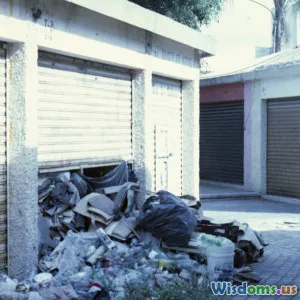
Why Food Waste Happens and Practical Ways to Prevent It
8 min read Explore key reasons behind food waste and discover practical strategies to curb it effectively at home and beyond. (0 Reviews)
Why Food Waste Happens and Practical Ways to Prevent It
Food waste is a paradox — in a world where millions face hunger daily, vast amounts of edible food end up discarded. According to the Food and Agriculture Organization (FAO), roughly one-third of all food produced globally is lost or wasted. This amounts to about 1.3 billion tonnes a year. But why does food waste happen, and more importantly, what can we do to stop it?
Understanding these questions is crucial for consumers, businesses, and policymakers alike. Let’s break down the root causes of food waste and then explore practical, actionable steps that can help curb this alarming trend.
Why Does Food Waste Happen?
1. Overbuying and Poor Meal Planning
One of the most common reasons food ends up in the trash is over-purchasing. Shoppers buy more than they can consume before items expire. Without clear meal plans, fresh produce and perishables often languish unused. A study by the Natural Resources Defense Council (NRDC) found that up to 40% of food waste at the consumer level stems from purchase and consumption decisions.
Example: Buying a large bunch of fresh kale but forgetting it in the refrigerator until it wilts and spoils.
2. Confusing Date Labels
Date labels on food packages, such as "sell by," "best before," and "use by," can be confusing. Many consumers interpret these as strict expiration dates rather than quality indicators, throwing away items prematurely. The UK's Waste and Resources Action Programme (WRAP) identifies confusing labels as a major driver of avoidable food waste.
Insight: In fact, many foods remain safe and nutritious well past the "best before" date.
3. Improper Storage Techniques
Proper food storage is essential to prolong freshness. Many people do not store fruits, vegetables, dairy, and leftovers correctly due to lack of awareness or limited refrigeration options. For instance, storing tomatoes in the cold can degrade flavor, while some produce require refrigerated conditions to last longer.
4. Plate Waste and Portion Sizes
At the restaurant and household levels, incorrect portion sizes or a mismatch between appetite and serving leads to food being uneaten and discarded. According to a 2021 USDA report, plate waste accounts for approximately 30% of the food wasted in the U.S.
5. Supply Chain Inefficiencies and Cosmetic Standards
Food waste also occurs upstream in transportation, storage, and retail. Strict cosmetic standards mean that “ugly” but perfectly edible produce often gets discarded by farmers or retailers. An estimated 20-40% of fruits and vegetables are rejected on this basis.
Practical Ways to Prevent Food Waste
1. Conscious Shopping: Plan Before You Buy
Developing a shopping list based on realistic meal plans greatly reduces impulse buys and over-purchasing. Apps like Mealime or Paprika can help organize weekly menus and grocery lists.
Tip: Check your pantry and fridge before shopping to avoid duplicates.
2. Decode Date Labels
Educate yourself on what date labels actually mean. The “best before” date signals peak quality, not safety, while “use by” dates relate to safety and should be adhered to strictly. Resources such as the USDA’s guidelines provide clarity.
Quote: Dana Gunders, author of "Waste-Free Kitchen Handbook," emphasizes that most foods are still edible after the “best before” date.
3. Improve Storage Practices
- Store herbs like parsley wrapped in damp paper towels inside sealed containers.
- Keep leafy greens in perforated bags with a dry paper towel to absorb moisture.
- Know which items like bananas and tomatoes should be kept at room temperature.
Investing in reusable storage containers and keeping access to your fridge organized can also prevent forgetting food.
4. Manage Portions and Use Leftovers Creatively
Cook mindful portions according to household appetite. When leftovers occur, repurpose them:
- Turn roasted vegetables into soups or frittatas.
- Use stale bread for croutons or bread pudding.
- Freeze leftovers in meal-sized portions.
5. Support and Advocate for Ugly Produce Sales
Buy "less-than-perfect" fruits and vegetables from farmers' markets or stores offering "ugly" produce boxes. This reduces waste upstream and promotes sustainability.
For example, companies like Imperfect Foods specialize in selling such produce, fighting food waste while making affordable groceries accessible.
6. Compost Food Scraps
While avoiding waste is best, inevitable scraps like peels and spoiled items can be composted. This organic matter enriches soil and reduces landfill strain.
Many cities now provide composting collections; alternatively, backyard compost bins are easy to maintain.
Real-World Success Stories
Denmark’s National Campaign
Denmark launched a “Stop Wasting Food” campaign in 2013 that educated consumers, retailers, and policymakers. The campaign contributed to a 25% reduction in household food waste in less than five years, demonstrating the power of coordinated effort.
Zero-Waste Stores
Stores worldwide are adopting zero-waste models, encouraging customers to buy only what they need and package-free. For example, stores like "Unpackaged" in London promote conscious consumption by selling food in bulk.
Conclusion
Food waste is a complex issue driven by behavioral patterns, logistics, and standards. However, informed choices and simple changes—like better shopping habits, understanding date labels, and creative reuse—can drastically reduce food thrown away by individuals and communities.
Each act of waste reduction not only saves money but also conserves precious resources and reduces greenhouse gas emissions tied to food production and disposal. As Dana Gunders notes, "Food waste isn’t just about lost food, it’s about lost opportunity — to nourish people and protect our planet."
By becoming mindful consumers, we can shift the narrative from wastefulness to sustainability and make a tangible difference one meal at a time.
References:
- Food and Agriculture Organization of the United Nations (FAO), "Food loss and food waste" report, 2013.
- Natural Resources Defense Council (NRDC), "Wasted: How America Is Losing Up To 40 Percent of Its Food From Farm to Fork," 2012.
- Waste and Resources Action Programme (WRAP), UK.
- USDA Economic Research Service, "Food Waste in the United States," 2021.
- Dana Gunders, Waste-Free Kitchen Handbook, 2015.
- Denmark’s Stop Wasting Food campaign data, 2013-2018.
Rate the Post
User Reviews
Popular Posts




















